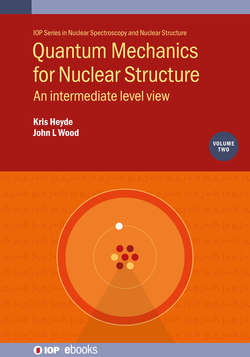Читать книгу Quantum Mechanics for Nuclear Structure, Volume 2 - Professor Kris Heyde - Страница 14
На сайте Литреса книга снята с продажи.
1.6 Tensor representations for SO(3)
ОглавлениеConsider the general SO(3) transformation of the vector V⃗
Vi′=∑iRi′iVi,(1.76)
where the Vi are the Cartesian components of the vector and the Ri′i are the elements of the 3 × 3 matrix R that effects the orthogonal transformation. This can be generalised to
Ti′j′k′⋯=∑i∑j∑k⋯Ri′iRj′jRk′k⋯Tijk⋯,(1.77)
where the Tijk⋯ are the Cartesian components of a tensor, the rank of which is equal to the number of indices and the Ri′i are, as before, elements of the 3 × 3 matrix R. Details are clarified in the following.
The simplest Cartesian tensor is of rank 2 and is often called a dyad or dyadic. It is formed from two Cartesian vectors, e.g.
U⃗=(U1,U2,U3),V⃗=(V1,V2,V3),(1.78)
Tij=UiVj,(1.79)
of which there are nine components. Thus,
Ti′j′=∑i∑jRi′iRj′jTij,(1.80)
where the Tij are the nine components of the dyadic and the Ri′iRj′j are the elements of the 9 × 9 matrix that effects the underlying transformation. We note that there are still only three parameters involved in describing this (SO(3)) transformation.
The nine components of T are reducible, i.e. they can be expressed as linear combinations that form subsets which transform among themselves under rotations. They are:
U1V1+U2V2+U3V3=U⃗·V⃗≔T,(1.81)
12(U2V3−U3V2)≔A1,(1.82)
12(U3V1−U1V3)≔A2,(1.83)
12(U1V2−U2V1)≔A3,(1.84)
i.e.
12(UiVj−UjVi)≔Akεijk.(1.85)
Further,
12(U1V2+U2V1)≔S12,(1.86)
12(U2V3+U3V2)≔S23,(1.87)
12(U3V1+U1V3)≔S31,(1.88)
U1V1−13T≔S11,(1.89)
U2V2−13T≔S22,(1.90)
i.e.
12(UiVj+UjVi)−13Tδij=Sij.(1.91)
The combination U3V3−13T is excluded because
U3V3−13T=−U1V1−13T+U2V2−13T.(1.92)
T is a scalar product which is invariant under rotations. The Ak are the three independent components of an antisymmetric tensor: by antisymmetric we mean that they change sign under exchange of the indices. The Sij are the five independent components of a traceless second-rank tensor. The trace, ∑i=13Sii is evidently zero from equation (1.92). Note that
UiVj=U⃗·V⃗3δij+(UiVj−UjVi)2+UiVj+UjVi2−U⃗·V⃗3δij,(1.93)
i.e.
UiVj=T3δij+Akεijk+δij.(1.94)
Consider a rotation around the z-axis through an angle γ:
cosγ−sinγ0sinγcosγ0001U1U2U3=U1′U2′U3′,(1.95)
whence
U1′=U1cosγ−U2sinγ,U2′=U1sinγ+U2cosγ,U3′=U3;(1.96)
and similarly
V1′=V1cosγ−V2sinγ,V2′=V1sinγ+V2cosγ,V3′=V3.(1.97)
Then for the Ak,
A1′=12U2′V3′−U3′V2′=12(U1sinγ+U2cosγ)V3−U3(V1sinγ+V2cosγ)=A1cosγ−A2sinγ;(1.98)
similarly
A2′=A1sinγ+A2cosγ(1.99)
and
A3′=A3,(1.100)
i.e.
cosγ−sinγ0sinγcosγ0001A1A2A3=A1′A2′A3′.(1.101)
Evidently, we can write
A⃗=12U⃗×V⃗.(1.102)
Further, for the Sij,
S12′=12(U1cosγ−U2sinγ)(V1sinγ+V2cosγ)+(U1sinγ+U2cosγ)(V1cosγ−V2sinγ)=(U1V1−U2V2)sinγcosγ+12(U1V2+U2V1)(cos2γ−sin2γ)=(S11−S22)sinγcosγ+S12(cos2γ−sin2γ)=12(S11−S22)sin2γ+S12cos2γ;(1.103)
similarly,
S23′=S23cosγ+S31sinγ,(1.104)
S31′=−S23sinγ+S31cosγ,(1.105)
S11′=−S12sin2γ+12S11(1+cos2γ)+12S22(1−cos2γ),(1.106)
and
S22′=S12sin2γ+12S11(1−cos2γ)+12S22(1+cos2γ),(1.107)
i.e.
cos2γ0012sin2γ−12sin2γ0cosγsinγ000−sinγcosγ00−sin2γ0012(1+cos2γ)12(1−cos2γ)sin2γ0012(1−cos2γ)12(1+cos2γ)S12S23S31S11S22=S12′S23′S31′S11′S22′.(1.108)
Similar equations can be obtained for S12,S23,S31,S11,S22 for rotations about the x and y axes.
The {Ak}, T, and the {Sij} transform separately under rotations. Dyadics are said to possess a reducible structure with respect to rotations.
